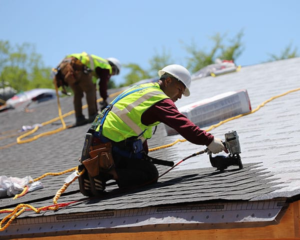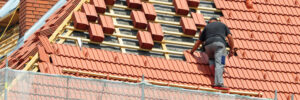A new roof gives you structurally sound handiwork that is backed by a warranty. However, there are things to consider before you agree to a replacement job.

Moss or fungus growing on your roof could lead to rotted boards that damage the structure of your home. A rotting roof is a sign that it’s time to replace your roof. Connect with EZ Roofing of Flagler County for reliable help.
A roof is one of the most important parts of any home, but it’s also one of the most expensive. While regular maintenance can help prolong the life of your roof, eventually, it will wear out and need to be replaced. A new roof can protect your home from damage and increase its value. However, the cost of a roof replacement can be prohibitive for many homeowners.
The costs associated with a roof replacement vary widely depending on the size and type of roof, as well as the materials used. The average new roof costs between $5,000 and $15,000, but this price can rise significantly if you opt for a premium material like slate or metal. Local labor rates and materials prices can also affect the overall cost of a roof replacement.
Choosing the right materials is an essential part of the roof replacement process, as it can determine how long your new roof will last and how much protection it will provide. The most affordable material is asphalt shingles, but if you want your new roof to last longer, it’s worth investing in more expensive materials like slate or metal.
Another factor that impacts the cost of a roof replacement is the extent of any existing damage. If the problem is limited to a small area, minor repairs may be enough to save your roof. But if the damage is extensive and widespread, a full replacement may be necessary.
It’s important to double-check your homeowner’s insurance policy before committing to a full roof replacement. Some policies cover the cost of a new roof if it’s needed due to storm damage. Otherwise, you’ll need to pay out of pocket.
The cost of a roof replacement can be high, but it’s an investment that will pay off in the long run. By planning ahead and comparing quotes from reputable roofing contractors, you can minimize the upfront expense. If you’re on a tight budget, consider negotiating with your contractor or asking for discounts. Also, consider asking for a payment plan to spread the costs over time.
Materials
There are many different roofing materials on the market, and deciding which is right for your home requires careful research. The most popular are asphalt shingles, metal roofs, and clay or slate tiles. Depending on your climate and style preferences, you may also consider concrete or ceramic tiles. While these are pricier than other options, they provide superior durability and can last 50 to 100 years or more. Additionally, a slate roof can add to the value of your property and make your house more energy-efficient.
The roof framing is another important element to consider. If it’s rotting or damaged, you’ll need to replace it with plywood or oriented strand board (OSB). The OSB will protect the sheathing from water damage and help prevent leaks. In addition to the main roof materials, you’ll need a variety of other supplies for your replacement project. These include pipe boots, drip edge, ventilation systems, and gutters.
Pipe boots are pieces of rubber that fit securely around the holes in your roof created for pipes that release gas or moisture from your home. Without these boots, water could enter the house and cause serious damage. Typically, the roofer will install them in areas that are particularly sensitive to leaks and penetrations, such as around chimneys, skylights, or vents.
Metal roofs are a popular option due to their durability and ability to withstand varying weather conditions. They can be fabricated to look like traditional asphalt shingles or shakes, and they usually last 30 to 50 years. They’re also resistant to fire, impact, and insects.
A clay or slate tile roof is an option for homeowners who want a premium roof with a classic, elegant look. These roofs are highly durable and last for about a century. However, they can be expensive to install and require special framing supports and a significant up-front investment.
If you’re undergoing a roof replacement, make sure to choose high-quality materials that will be eligible for an insurance discount. Otherwise, you’ll need to pay for costly repairs or replacements down the road. In addition, be sure to hire a certified contractor and keep detailed records of the work completed.
Installation
If you have a deteriorating roof that is beyond repair, it’s time for a replacement. A new roof will protect your home from the elements, and it can even increase its value. It’s important to hire a professional roofing contractor for this project. They will inspect the existing roof to ensure that there are no leaks or structural issues. They will also take into account the climate and weather patterns of your area when choosing the best roofing materials.
After the old roof is removed, your roofing contractor will prepare the area for the new roof by cleaning and sealing it. They will then install ice and water sheathing, drip edges, and flashing. This will keep rainwater from seeping through the roof into your house. Flashing is especially important around chimneys, wood stove pipes, vents, and hip roofs. Roofing cement will also be applied to the flashing areas to seal them.
The next step is to install the shingles. Your roofing contractor will choose a style and color that complements your home. The number of shingles installed will depend on the size of your roof and the type of material used. For example, asphalt shingles are the most popular choice, but wood shake and slate can offer a more unique look. Your roofing contractor will determine the amount of shingle overlap needed for a secure fit and will cut the shingles accordingly.
Once all the shingles are placed, your roofer will install ridge capping. This is the area where the shingles meet on either end of your roof. A ridge cap is installed with the shingles going in opposite directions to prevent water or ice from leaking through this point.
After all the shingles are placed, your roofing contractor will clean up the area and blow off debris from the tarps. They will also inspect the eaves, valleys, and flashing. If any of these are damaged, your roofing contractor will replace them. They will also seal the joints to keep moisture from seeping into the attic.
A professional roof replacement requires a significant investment of both money and labor. However, a good roof can last for decades and will protect your home from the elements. Additionally, a properly installed roof will ensure that your homeowners insurance covers any future damage.
Insurance
Homeowners insurance provides financial peace of mind, guaranteeing that if your home is damaged, the insurer will help you pay for repairs. Roof damage is one of the most common reasons homeowners file claims. However, many people are confused about whether their home insurance covers a new roof. It depends on a variety of factors, including the age of the roof and how much coverage is provided by the policy.
Most standard home insurance policies provide coverage for your roof on an open perils basis, meaning that it is covered against damage caused by most sources. This includes wind, hail, and lightning. In addition, some home insurance companies may include loss of use coverage that will reimburse you if you have to stay elsewhere while your roof is being repaired.
When examining your home insurance policy, you should also note the amount of coverage and whether it is actual cash value or replacement cost. An ACV policy only pays you for the depreciated value of your roof, while a RCV policy will pay you enough to replace it with a comparable roof. You should also understand that your policy will likely require you to replace your roof if it is damaged so severely that it can’t be repaired.
Many people are concerned about how filing an insurance claim will affect their premiums. It is important to remember that your premiums will be based on how risky you are as a homeowner, so submitting too many claims can increase your risk profile and lead to higher rates in the future. It’s also important to note that if your claim is denied, you’ll have to pay for the repair yourself.
It is also worth noting that a well-maintained or newly replaced roof will typically offer greater protection against external elements, which can lower your insurance premiums in the long run. This lowered risk is why many insurers offer discounts for homeowners who upgrade their roofs. If you’re interested in learning more about how to get a new roof with homeowners insurance, contact us today.


